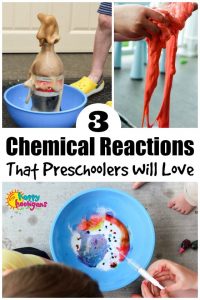These chemical reactions are safe and educational for young children and require just a few household supplies and ingredients. Your kids will make baking soda fizz, they’ll make a diet coke explosion, and turn a liquid to a solid with these easy but fascinating science-based activities.

We have loads of easy science activities here among the pages of my blog. But not a lot of chemistry experiments because it can be challenging to find chemicals that preschoolers can safely explore.
You may like our:
Maybe it’s because I didn’t study chemistry in school. Or maybe it was because I was just overthinking things. Either way, it took me a while to figure out that preschool chemical reactions can be quite simple and fun!
The experiments below are perfect for homeschool, daycare or the preschool classroom, and a great way encourage to introduce young children to science.
3 Easy Chemical Reactions For Preschoolers
For your conviencience, this post contains affiliate links. As an Amazon associate, I earn from qualifying purchases.

Baking Soda Fizz Experiment:
This preschool science experiment is about as basic as it gets but it’s lots of fun. While exploring this chemical reaction, kids will observe what happens with vinegar reacts with baking soda. This activity is great for strengthening fine motor skills too, which will help prepare kids for printing and writing.
Supplies:
- Bin or pan
- Plastic cup
- Box of baking soda
- Food colouring (optional)
- Medicine droppers or pipettes
- Card stock (optional – for making prints)
Instructions:
- Empty a box of baking soda into a pan or bin. Spread it out evenly.
- Drip different food colouring combinations throughout the baking soda.
- Fill a plastic cup with vinegar.
- Using pipettes or medicine droppers, have the kids drip or squirt the vinegar on to the baking soda.
- Once they have seen the fizzy chemical reaction happen again and again, they can press card stock on top of the baking soda and vinegar to make a coloured impression!
Diet Coke and Mentos Explosions:
I highly recommend doing this outside so you wash away the sticky results with a hose. A kiddie pool or large basin is handy if you want to contain the results.
To understand why the mentor and Diet Coke react together the way they do, and to see the experiment in action, check out the awesome Steve Spangler video below:
Supplies:
- Bottle of Diet Coke – other soda will work too – just not as well
- Original Mentos – the flavoured variety has a candy coating
- kiddie pool or large basin (optional)
How-to:

- Take your kids outside.
- Using a large container or an empty driveway, open the bottle of Diet Coke and have your children drop the Mentos into the bottle.
- Then back up fast!
Dripping Slime Experiment:
The first time we did this activity, my kids were under the age of three. Years later, this is still one of their favourite activities of all time. They are now old enough to execute the entire chemical reaction on their own.
This chemical reaction works because the borax forms borate ions that bind to the liquid-like polymers in the glue. This makes the glue flow less easily becoming more of a solid.
Note: if using Borax, this activity should not be done with children who might taste the slime. For a non-borax slime, see this recipe.
Supplies:
- 1 cup hot tap water
- 1 tsp Borax
- 1 bottle White school glue (120 ml)
- 1/4 cup tap water (temperature doesn’t matter)
- food colouring (optional)
- Colander or cooling/baking rack
- String
- Scissors (optional)
Instructions:
- Measure one cup of hot water and mix in Borax until fully dissolved.
- In a separate container, combine glue, 1/4 cup of water and food colouring.
- Mix well, and then mix in the water-Borax mixture. There will be excess water left over in the bowl. That’s okay.
- Then, hang a cooling rack or colander. We’ve used cupboard handles or balanced a cooling rack across two chairs. Make sure the floor below isn’t carpet.
- Place the slime on the cooling rack. Wait. It can take a while. Slowly, you’ll see the slime drip down.

Optional: Encourage kids to grab scissors and cut the drips.
So, you see? Explaining chemical reactions to preschoolers really isn’t hard at all with easy science experiments like this! Now that you’ve seen how fun and easy it can be, I hope you’ll try them with your kids.
Be sure to check out this collection of 20 easy science activities for toddlers and preschoolers.

















Maddy
How much of the white school glue do you add?
Jackie Currie
Hi Maddy! I just edited the post to clarify. It’s 1 regular sized bottle (120 mL size). Thanks for asking! I hadn’t noticed that I hadn’t specified the amount.
Sarah Siciliano
Hi! Your blog is great and I been looking at it for pre-school ideas. I am a science teacher but I am new to working with such little ones. The mentos and soda experiment is a popular one with kids of all ages. I just wanted to note that it is not actually a chemical reaction, just a physical one. I know it is hard to believe because the result seems so “big” but there are actually no new substances being produced.